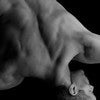Description
About This Video
Transcript
Read Full Transcript
Hi everybody. I'm Tom McCook. I'm here back again at [inaudible] anytime with Christie and Nicole. Great pleasure to be back. And um, today's first lesson is gonna be on the fact that we all sit all the time. That's not gonna Change. So why not learn to do it better and learn how to do it in a way where you can be efficient and not create a lot of imbalances in your body.
So we're going to do a few things that actually make you feel good and sitting and actually learn how to lower your center of gravity and let go of tension around the neck and shoulders. I think you'll enjoy. And I recommend you bring this into your life. So the first thing we're going to do, think of posture when you're sitting starts from your pelvis up because we're sitting on our, on our sit bones. So here's a model of the pelvis. I always have one with me wherever I go. So basically your sit bones are at the bottom and we're sitting on them. And if you can see from a side view, they're kind of oval. So you can maybe have the analogy that they're, they're like a canoe and when you're sitting you don't want to be in the back of the canoe.
Cause then your head's in the front of the canoe and then your spine is actually a little bit compromised when we're hanging off of muscles that tend to get overworked without even knowing it. So we're going to learn how to use the Franklin balls and just awareness of how to sit well and then notice that when you're sitting at, actually it will be a lot more comfortable. So the first thing I want to do is I just want you to touch your sit bones. Your sit bones are right at the bottom of your butt. Just leaning to one side. Just touch them. Say, wow. Yeah, those are my buttons. Who, who knew? Usually if your glutes are out of the way, it's a little easier to find. There you go. This, feel that one, and then just lean to the other side and feel the second one.
Say thank you very much. Sit bones. Now from there we're going to take the two Franklin balls, which we have right next to us. Now if you don't have Franklin balls, you can use any balls that are similar like this size. I recommend, I recommend really hard balls cause that would feel a little less comfortable. Now we're going to put them under our sip phones. So just carefully put them there. And then I recommend you have your feet flat on the floor a little bit forward.
Uh, can be a little treacherous. That's an edge. Just take a couple breaths and just let your pelvis sink on the balls where you just get a sense that, okay, I'm on this slightly unstable surfaces, a little more squishy and it's giving me feedback into my sit bones. I said, you're, you're already might notice you're already sitting up a little straighter because you're a little more alert. So now from here, all I want you to do is take the pelvis is gonna rotate like this. So when the pelvis rotates, one knee will go forward. One day we'll go back. So imagine you're going to draw one knee back is when he goes forward. So you start to massage the tissue that the balls are resting on.
That's Kinda Fun, Huh? You didn't know you had all these great tools. Now you can do when you're sitting, especially when your work is actually getting really boring and to see one femur head is sliding forward, one famers sliding back and the pelvis is rotating with that. So you're not necessarily trying to brace or prevent the upper body from turning at all. That's it. Let's do that and just notice. Another thing that we want to do and we're trying to improve environment is breathe smoothly and actually as best you can stay relaxed in your arms, your neck and your jaw. That's it. Now as you come back to the middle, take your feet a little wider.
I just want you to hinge forward like you're going to pick something up and come back up and think of hinges as opposed to rounding so you can feel how now the ball is massaging the top of the hamstrings and the glutes a little bit differently. Just alternate your hands a few times. So you're just getting a sense of hinges on your pelvis over the top of your legs. That's it. One or two more.
That's it. So now that right sit bone is in the air and I'm going to go from a coffee. I'll be back in about an hour. So you just have to deal with that. I'm just kidding. So now as you inhale, let the right sit bone lower towards the seat. Now as you exhale, draw it back up and I want you to imagine this is going down.
The sit bones are widening in the pelvic floor. Slowly stretching. Now exhale, draw up. So you feel that your pelvic floor is lifting as you exhale, following your respiratory diaphragm. And just be conscious that don't drive super hard from the leg. Feel like it's coming more from the pelvis and the legs supporting that. But you're not just pushing hard from your leg.
Do you want to feel like you're doing it from your pelvis? That's it. And if you have a little bit of a smile, it's way better. That's it. Just two more like that. And not feel that lift against you. Can I keep my shoulders and neck soft? It's a little unstable. Now I lift and hold. Now imagine that the fixed point where the ball is, you're going to rotate around the other sit bone is in the air.
Now reached the sit bone that's in the air forward and back. So you're rotating the pelvis around the fixed point. Now that's it. And smooth breathing, getting all that tissue to wake up. So there's a little stability element and there's also a little bit of a massage.
Now like I really feel them. You get a sense of that, right? So that's, think of that's for posture and moving. Well, we want to teach your body to keep our center of gravity as low as possible as often as possible. That way our neck and shoulders are supported from the ground and from our pelvis. Let's take side too. So put it under your rights at phone now and then have it in the air for a moment. Imagine you're holding it up from obviously from your leg support, but you're also holding it up from your pelvic floor muscles and a little bit of your abdominal muscles. As you inhale, lower the sit phone down now XL lifted up and just feel that the space between your tail, your pubic bone, you two sit bones, it gets a little smaller. As you lift that whole aperture of the pelvic floor draws together. That's it. So this is a pelvic floor exercise. Also two more as best you can keep the hip joints relaxed and one more.
Now keep the lift and now the fixed point is the right ball. Now you're going to rotate the pelvis forward and back around the fixed point.
So we need to learn how to transition when we go to standing from the sit bone to the, to the hip joint. When you do that, I'll just give you a view of it with the femur attached. So imagine that we're not for me to transfer without rounding my back, I need to roll the pelvis over the top of the Femur and then shift the weight onto my femur and from the Femur, lift myself up and then ride back down on my femur without distorting the shape of the spine. And that's a skill. But everybody has that ability built into their system. They just need to learn how to do that and we can learn. We can get better at it through practice. Okay, cool. So from there, let's go to the under the, we'll come back to this.
Go to the other end of the spine. So I'd like you to put your fingers in you at home. I'm watching where you believe your head sits on your spine. So like you guys, just to put your fingers wherever you feel like your head sits on your spine. I'm going to go here and I'm just kidding. Like, like where does the head meet the spine?
You go ahead and put your, yeah, I just put your fingers where you believe that it is.
And just remind yourself you're going to get some really useful information right now. Now, right below your ears, you'll feel a bone called your mastoid process. It's a hard bone, a little rounded piece to edit the bottom. Go to the very tip of it and put your fingers at the tip and put your fingers lined up towards one another. Not directly between your fingers is where your head sits on the spine that close to the middle. So our heads designed to rock right there and just do a little rocking. Now keeping it there.
Notice what happens if I rolled to the back of my sit bones and now nod. Notice how the quality of the movement has changed. Maybe a little stiffer, little less clear. Now get back up on the sit bones
And this is the first two cervical Vertebra, the atlas, which are c one and c two, which is right below it. So the head sits in these two spoons, is fit these uh, cups of the atlas and it rocks right there. And the head has about that much range, a decent amount of range before the shape of the neck changes at all before this. Any spinal movement. That's kind of an interesting thing to understand. So what happens, what we tend to do, because of our lifestyles, we tend to take the head out in front and we're hanging off of C7 instead of having the head right up over the spine. So let's just with that idea, let's try this again to touch the mass processes. Now notice that they're kind of oval.
Now visualize that when you nod your head and you feel how those maps really processed, slide back. Think the sip bones of the head are mirroring that, that the sit bones are the head that are inside on the top of the spine, are sliding back in the spoons of the atlas as you nod your Chin.
You have much more movement options in any direction at any given time. Now, so that's where the weight of the head rests. Now another way you can improve function up here is to feel where is there no support? Where are the places where of release? So put one thumb under your jaw and think of your tongue muscles are there, and slide the other hand down the back of your head. And to come into what's called the neck pit, where it starts to indent. And imagine both of these places are soft and deep.
And as you nod your head again, just press your fingers into these places and just note if you want these places to be soft and deep because neither place is supporting any weight you want them to be really easeful might notice it's a little easier to feel the articulation with that idea. That's it. And now the next time somebody's talking to you and you really not that interested, you have something to put your attention on and just nod and say whatever you say. That's it. And it's to a couple more like that. And then come back and just take a moment to notice.
Feel a little difference from that. Now let's just do a little bit of lengthening. So let's just lump a little bit. Now as you rock up onto your sitcoms and inhale, I want you to push down into your hands and rock right up onto your sit bones and just feel your head float up to your variet on the top, the heads floating on the top, and exhale, just relaxing again and sense that you initiate from the pelvis. You roll up onto the center of your sit bones and you lengthen up. That's it. And just do that two more times. You're creating a little axial length.
You're going down to go up
So imagine what we want to do is to have that be a little more lengthened in the front, a little more slid down in the back. So touch the top of your breastbone right at the very top, and visualize from a side view. I'll just do this for you. So imagine right where you're touching from a side view is this part of the spine. And then right above that is the neck. Those are the curves of the spine. So that's the thoracic outlet. So what you want to do there, it just feel what it feels like to draw that part of where you're touching, not your chin, but that part straight back and feel like what's below it goes slightly forward. And the whole upper spine from your mid chest, your neck, extend slightly, it lengthens.
And just picture that the muscles in your middle back don't attach to your arms so you don't have to tense your arms. That's this is really coming from your rhomboids. That's it. And now retract. And now do that feeling of of s, of taking the throat straight, that or the bottom of the throat, straight back. And hold that for a couple of breaths. You've started to feel the muscles in the middle of your upper back.
Start to get warm and relaxed. Your jaw, and then let it go. Now let's do it with the hands here. You're right at the bottom. The top of the breastbone drops straight back and now pull the blades back to the shoulders. Draw back slightly. So you're waking up those muscles close to the spine and the Rom boards that are right on top of them, middle fibers of your traps.
You're nice and fluid. You have equal pressure to both feet. Your breath is easeful. That's it. Add one more. Now back to the center and bring your fingertips to the back of your head a little bit wide so they're not touching each other and bring the elbow slightly back. Now we're going to do that upper back extension with our hands here. So get up on the sit bones, the bottom of your bar at the top of your breastbone. Drive straight back. And now start to go up and press the elbow slightly back.
And then slowly back to neutral. And again, retract the base of the neck. Go up by mom and then back to neutral. And again, two more. Go Up, drop back and go up. That's it. And one more drawback and go up and back to center. Now keep your fingers there. So we're going to do a side bending and the challenge is going to be to not let the head drop forward. Elbows a little back. Press into both sit bones and side bend to your right and back to center and out of your left and back to center. And right before waking up that middle back a little bit and again to your left, back to center. One more read side.
Back to center. Last time. Back to center. Release the arms, Huh? And it's, notice how your Nice and upright now. And we're going to include one more thing, a contraction for your lats. Your lats are a muscle that connects your upper arm to your pelvis, is the only muscle that connects your arms to your pelvis. So your arms are going to be by your side.
So first just feel that little bit of retraction of the base of the throat and reach into your sit bones. Now exhale, just press the arms back, inhale forward and again and feel like the pressing back actually feels like the spine gets longer. That's it. Just two more and press back.
Let me give you that in for you one more time. And what I recommend you do is stagger your feet. That sense there'll be a little easier to transfer. So we're going to go from the sit bones to the femur head and then up. So what I want you guys to feel first is put your fingers in your armpits.
I won't say anything else after that that take a breath in on the exhale. Just imagine you're going to soften your armpits like you're flushing out tension. Relax your jaw now. Just become aware that you're on your sit bones and let the arms hang. Now see yourself rolling the pelvis forward over your legs. Imagine your head is staying aligned with the spine. Just transfer onto your femur heads now from your femur heads, keeping the shoulders, the arms relaxed.
Come up to standing and now from your femur heads float back down and then switch your legs. And again, feel like you're going to hinge. Shoulders are useful. Transfer onto your femur heads. You have all these reflexes built into your body to do this and then come right up. Then we'll bring our feet into square and I would just going to ride down on her femur heads. So ride down since the middle and then transfer and lift. And then at the top bring your head, your fingers back to where your head sits on your spine, not a few times, and then relaxed your arms. Notice, posture breathing, and there's your less than four seated posture. Thank you for joining us.
Comments
More mindful movement opportunities each day in the midst of busy lives to connect, align and refresh! I'm happy to hear you enjoyed! Thank you Pilates Anytime!
You need to be a subscriber to post a comment.
Please Log In or Create an Account to start your free trial.

















